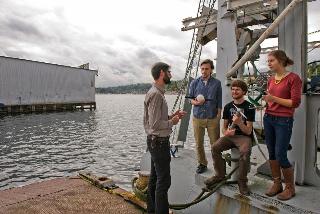Oct 27 2014
The U.S. Navy has committed to get half of its energy from renewable sources by the year 2020. One element of that strategy will be looking to extract energy from tides, currents and waves. The University of Washington is helping to reach that goal with an $8 million, four-year contract from the Naval Facilities Engineering Command, or NAVFAC, to develop marine renewable energy for use at the Navy's facilities worldwide.
 Andy Stewart (left) and UW mechanical engineering graduate students with 3-D printed prototypes of different tidal turbine designs. Credit: Mary Levin / UW
Andy Stewart (left) and UW mechanical engineering graduate students with 3-D printed prototypes of different tidal turbine designs. Credit: Mary Levin / UW
The goal is to generate energy from the surrounding water at coastal bases, islands or overseas facilities in order to lower costs and increase reliability of the power supply. Forming a partnership with NAVFAC will allow the UW to develop tools for the Navy to predict and tap energy at its various marine locations.
"We are advancing existing technologies and concepts so they will perform well at naval facilities and help reach their energy targets," said lead investigator Andrew Stewart, an engineer at the UW's Applied Physics Laboratory. He will present information about the project Oct. 25 in Seattle at the Northwest National Marine Renewable Energy Center's annual meeting.
The team has a three-pronged strategy to develop marine energy at naval facilities, which differ from the prime spots now under investigation for commercial marine energy extraction.
In the past three months UW mechanical engineering faculty and graduate students have made 3-D printed prototypes of tidal turbines that they will test in the UW's water channel and with computer modeling studies.
Next they will take the most promising designs and build larger-scale models, about 3 feet across, to test in moving water in 2016. One aim of the project is to develop fast, low-cost ways to evaluate the energy potential at prospective sites.
"We've learned that you can't rely on modeling," Stewart said. "You need in-water verification of marine energy resources."
This project is not focused on one specific design but instead will look at different technologies.
"The idea is to conduct the research that's needed to fill the gap between where the technology is now and where it needs to be for the Navy to take maximum advantage of the currents, tides and waves, as well as wind," Stewart said.
The third aspect of the project is developing low-cost monitoring technology to make environmental monitoring at naval facilities more straightforward.
The team will soon begin to modify the Applied Physics Laboratory's Henderson research vessel to test small-scale marine energy prototypes. The boat, a catamaran barge, was initially built for research on underwater sound. It is well suited for marine energy work because it is stable and allows researchers to lower equipment off the front of the boat, into water undisturbed by the boat's wake.